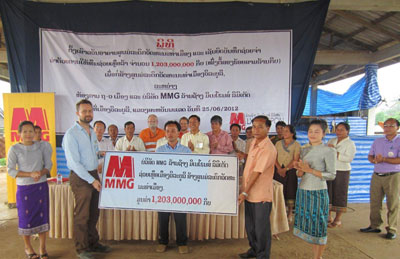-
Media Enquiries -
Somsavath Phanthady
Communications Superintendent
MMG LXML SeponT +856 21 268 407
M +856 20 2221 2632
E somsavath.phanthady@mmg.com
-
Work has commenced on the construction of a Cultural Heritage Centre in Vilabouly district, Savannakhet province. The US$150,000 project is being funded by MMG LXML Sepon.
A groundbreaking ceremony, held on 26 June, was attended by representatives of both the local authorities and the mine.

The Cultural Heritage Centre will be led by local community members
“The Centre will not only identify and protect cultural heritage, but will also ensure that local communities are fully involved in this process,” said Warren Mayes, Acting Manager of the mine’s Social Sustainability department.
A Community Heritage Advisory Group will also be established, made up of key local stakeholders filling a regular planning and consultation function in quarterly communication with MMG LXML Sepon Cultural Heritage Unit. The group will guide the work of the centre and help ensure that it is meeting its objectives.
Inpone Thephetlusy, Deputy Superintendent of the mine’s Cultural Heritage unit, said that the centre should not be understood simply as a museum for displaying objects. “Our purpose is much broader – we want the centre to promote the diversity of both tangible and intangible cultural heritage, and to be run by the local community,” he said.
Tangible cultural heritage includes historical artefacts, such as those found during mining activities and the annual archaeological digs at the mine.
Intangible cultural heritage includes customs, beliefs, songs and stories. The mine has started to undertake research into these aspects of local culture; in 2011, more than 230 musical performances were videoed around Vilabouly district as part of this process.
Many of the artefacts found over recent years have been highly significant. In 2008, a Dong Son bronze drum – one of the largest specimens ever found – was unearthed. This drum, believed to be at least 2,000 years old, is now on display at the National Museum in Vientiane. This was followed in subsequent years by the discovery of ancient mine shafts and a second bronze drum, found by community members.
Many of the smaller artefacts discovered, such as those related to the production of copper, as well as items made from the metal, have been temporarily stored at the mine’s Cultural Heritage Workshop. Once the Vilabouly Community Cultural Centre is completed, these objects will be displayed there.
The mine’s cultural heritage program works in close collaboration with the Department of Heritage of the Ministry of Information, Culture and Tourism, and with James Cook University in Australia.
-end-